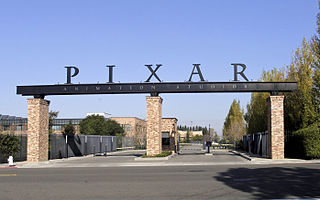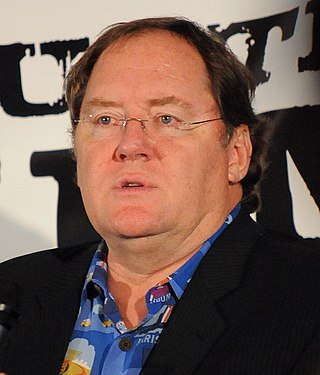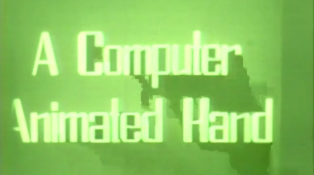
Pixar Animation Studios is an American computer animation studio known for its critically and commercially successful computer animated feature films. It is based in Emeryville, California. Since 2006, Pixar has been a subsidiary of Walt Disney Studios, a division of Disney Entertainment, which is owned by The Walt Disney Company.

Edwin Earl "Ed" Catmull is an American computer scientist who is the co-founder of Pixar and was the President of Walt Disney Animation Studios. He has been honored for his contributions to 3D computer graphics, including the 2019 ACM Turing Award.
The Computer Graphics Lab was a computer lab located at the New York Institute of Technology (NYIT) in the late 1970s and 1980s, founded by Dr. Alexander Schure. It was originally located at the "pink building" on the NYIT campus.

Luxo Jr. is a 1986 American computer-animated short film produced and released by Pixar. Written and directed by John Lasseter, the two-minute short film revolves around one larger and one smaller desk lamp. The larger lamp, named Luxo Sr., looks on while the smaller, "younger" Luxo Jr. plays exuberantly with a ball to the extent that it accidentally deflates. Luxo Jr. was Pixar's first animation after Ed Catmull and John Lasseter left Industrial Light & Magic's computer division of Cinetron Computer Systems. The film is the source of Luxo Jr., the mascot of Pixar.

John Alan Lasseter is an American film director, producer, screenwriter, animator, voice actor, and the head of animation at Skydance Animation. He was previously the chief creative officer of Pixar Animation Studios, Walt Disney Animation Studios, and Disneytoon Studios, as well as the Principal Creative Advisor for Walt Disney Imagineering.
Pixar RenderMan is proprietary photorealistic 3D rendering software produced by Pixar Animation Studios. Pixar uses RenderMan to render their in-house 3D animated movie productions and it is also available as a commercial product licensed to third parties. In 2015, a free non-commercial version of RenderMan became available.

The Adventures of André & Wally B. is a 1984 American CGI-animated short film that was groundbreaking by the standards of the time and helped spark the film industry's interest in computer animation. The film was produced by the Lucasfilm Computer Graphics Project, a division of Lucasfilm and the predecessor of Pixar.

Loren C. Carpenter is a computer graphics researcher and developer.

Bolt is a 2008 American computer animated comedy-adventure film produced by Walt Disney Animation Studios and released by Walt Disney Pictures. The 48th Disney animated feature film, it was directed by Chris Williams and Byron Howard and produced by Clark Spencer, from a screenplay written by Williams and Dan Fogelman. The film stars the voices of John Travolta, Susie Essman, Mark Walton, Miley Cyrus, Malcolm McDowell, Diedrich Bader, Nick Swardson, and Greg Germann. This was also one of the final film roles for James Lipton before his death in 2020, the other being Igor, which was released the same year as Bolt.

Alvy Ray Smith III is an American computer scientist who co-founded Lucasfilm's Computer Division and Pixar, participating in the 1980s and 1990s expansion of computer animation into feature film.

Daniel Robert Gerson was an American screenwriter and voice actor, best known for his work with Pixar Animation Studios and Walt Disney Animation Studios. He co-wrote the screenplays of Monsters, Inc., Monsters University and Big Hero 6, which was reported to be his last film as screenwriter.

Circle Seven Animation was a short-lived division of Walt Disney Feature Animation specializing in computer-generated imagery (CGI) animation and was originally intended to create sequels to the Disney-owned Pixar properties, leading rivals and animators to derisively nickname the division "Pixaren't". The studio did not release any films during its existence, nor were any of its scripts used by Pixar.

Patrick M. Hanrahan is an American computer graphics researcher, the Canon USA Professor of Computer Science and Electrical Engineering in the Computer Graphics Laboratory at Stanford University. His research focuses on rendering algorithms, graphics processing units, as well as scientific illustration and visualization. He has received numerous awards, including the 2019 Turing Award.

Computer graphics deals with generating images and art with the aid of computers. Today, computer graphics is a core technology in digital photography, film, video games, digital art, cell phone and computer displays, and many specialized applications. A great deal of specialized hardware and software has been developed, with the displays of most devices being driven by computer graphics hardware. It is a vast and recently developed area of computer science. The phrase was coined in 1960 by computer graphics researchers Verne Hudson and William Fetter of Boeing. It is often abbreviated as CG, or typically in the context of film as computer generated imagery (CGI). The non-artistic aspects of computer graphics are the subject of computer science research.

Alexander Schure was an American academic and entrepreneur. Schure founded the New York Institute of Technology (NYIT) in 1955. He also served as the Chancellor of Nova Southeastern University (NSU) from 1970 until 1985.
The history of computer animation began as early as the 1940s and 1950s, when people began to experiment with computer graphics – most notably by John Whitney. It was only by the early 1960s when digital computers had become widely established, that new avenues for innovative computer graphics blossomed. Initially, uses were mainly for scientific, engineering and other research purposes, but artistic experimentation began to make its appearance by the mid-1960s – most notably by Dr Thomas Calvert. By the mid-1970s, many such efforts were beginning to enter into public media. Much computer graphics at this time involved 2-dimensional imagery, though increasingly as computer power improved, efforts to achieve 3-dimensional realism became the emphasis. By the late 1980s, photo-realistic 3D was beginning to appear in film movies, and by mid-1990s had developed to the point where 3D animation could be used for entire feature film production.

A Computer Animated Hand is the title of a 1972 American computer-animated short film produced by Edwin Catmull and Fred Parke. Produced during Catmull's tenure at the University of Utah, the short was created for a graduate course project. After creating a model of his left hand, 350 triangles and polygons were drawn in ink on its surface. The model was digitized from the data and laboriously animated in a three-dimensional animation program that Catmull wrote.

The Kahlert School of Computing is a school within the College of Engineering at the University of Utah in Salt Lake City, Utah.















